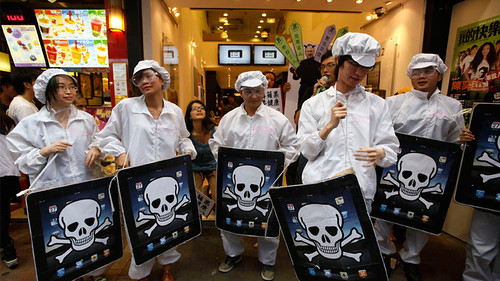Green Supply Chain VS. Efficient Supply Chain
As I discussed in my first blog, efficient supply chain can reduce the cost in the chain effectively like the way IKEA has been implementing, for example. However, the world is evolving with the rise in concern about the polluted environment caused by human's work, precisely by companies and organizations which manufacture without taking environment protection into their account. Those companies and organizations are under very high pressure from the public, NGOs(non-government organizations) and the governments. It is a new challenge for other firms to make decision to adjust their non-friendly environmental supply chain system into friendly environmental system because of incurred and high switching cost.
In this case, I want to point out three examples of three different manufacturing companies which are trying to find their best solutions. This will help us to criticize the decision made by those three companies.
APPLE
(Image source: http://www.themobilewallpapers.com/v/IPhone/Apple+Iphone+Dark+Mobile+Wallpapers+Apple+Black+Iphone+Backgrounds.jpg.html )
Everyone knows how excellent Apple's products are! The iPhone and the iPad are making a new trend in designing a mobile device. However behind the artistic design of Apple, they have faced many environmental issues from its suppliers. THE NEW YORK TIMES had an article on September 1st 2011, "Apple Cited as Adding to Pollution in China". The article revealed that:
"A Chinese environmental group has singled out Apple for criticism, accusing the company’s Chinese suppliers of discharging polluted waste and toxic metals into surrounding communities and threatening public health."
The group is Institute of Public and Environmental Affair in Beijing having a report which suspected that Apple supplier has “fail to properly dispose of hazardous waste. In addition, the working condition in the manufacturing factories were not up to the standard. The article also pointed:
"Also earlier this year, Apple acknowledged that 137 workers at a Chinese factory near the city of Suzhou had been seriously injured by a toxic chemical used in making the signature slick glass screens of the iPhone."
Demonstrator in Hong Kong protest against Apple on poisoning their workers.
(Image credit: AP Photo)
Even though Apple made a lot of efforts to explain that the company had been trying to audit regularly its suppliers, there is still a question for them to answer: “So how do you fulfill your commitment if you do not consider that you have responsibility in your suppliers’ pollution?”, asked by Mr. Ma Jun, the director of the Institute of Public and Environmental Affair. This article gave us an interesting insight of the scenes behind very beautiful products from Apple, there were still a lot of ugly consequences which affected the environment.
ORGANIC COTTON MANUFACTURER
We have heard a lot about organic food, but we might rarely hear about organic cotton. Reason? The green organic cotton manufacturer is facing the problem that the price is on the high side. The production of organic clothing is not people
imagination of so simple and easy. Firstly, the procurement of raw materials,
to confirm that the purchase is organic cotton, is the very headache process. Most of
the cotton farmers still use chemical fertilizers and pesticides. To solve the problem of the organic cotton raw material stock, the cost is high.
According
to Lu Yuan organic clothing, company's chief executive Ba Song said:
"Choose as a raw material, organic cotton production FuZhuangShang only in the yarn spending by 20%, which makes us into dilemma, either raise retail price, or sacrifice the profitability of products. Now buyers and sellers to price highly sensitive to any kind of choice will cause a party's interests are violated."The green supply chain falls into a dilemma, where the cost is much higher while the profit of the business still needs to meet the expectation.
HERMAN MILLER
In 1991, members of the Environmental Health and Safety group drafted a series of guidelines called "Design for Environment" (DfE) in an effort to formalize environmental aspect of its design process.
"We don't make decisions that will put us at a disadvantage in the market. It doesn't do the world any good if we go out of business because we're nice guys. We want to be in business AND be nice guys"Herman Miller has proved its right decision when choosing recyclable material and eliminating all material like PVC, for example, could become a toxic waste at the end of product useful life. It also forced its supplier to switch to follow the program to supply recycle materials.
Herman Miller is one of the most successful furniture companies in over the world. Inspired? Let's watch the following video to know more about Herman Miller.
<http://www.nytimes.com/2011/09/02/technology/apple-suppliers-causing-environmental-problems-chinese-group-says.html?_r=1>
<http://www.fsidoshow.com/EN/content/?61.html>
<http://www.youtube.com/watch?v=krhH_H7EaQg>




No comments:
Post a Comment
Note: Only a member of this blog may post a comment.